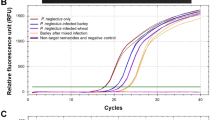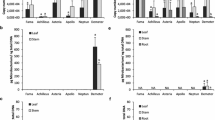Abstract
Polymyxa graminis, a root endoparasite of several cereal species, is considered to be non-pathogenic but serves as a vector of various plant viruses belonging to the genera Bymovirus, Furovirus, and Pecluvirus. Specifically, it reduces barley productivity by transmitting the Barley Yellow Mosaic Virus (BaYMV). To date, due to its obligate biotrophic property, no artificial culturing of P. graminis was reported and its quantification was also technically challenging. Here, we developed a novel and simple method to infect P. graminis within sterile barley roots in contamination free by preparing nearly pure zoospore inoculum. Such artificial maintenance of P. graminis was verified based on the presence of various developmental stages in infected barley roots under microscope. In addition, the population of resting spores in host tissue was determined by establishing standard curve between manually counted number of spores and Ct values of 18S rDNA amplification using quantitative real-time PCR. Furthermore, it was validated that standard curve generated was also applicable to estimate the abundance of P. graminis in soil environments. In conclusion, the present study would help to generate a system to investigate the etiological causes as well as management of plant diseases caused by P. graminis and BaYMV in tissue and soil.




Similar content being viewed by others
References
Delfosse P, Reddy AS, Legreve A, Thirumala DK, Abdurahman MD, Maraite H, Reddy DVR (2000) Serological methods for detection of Polymyxa graminis, an obligate root parasite and vector of plant viruses. Phytopathology 90:537–545. doi:10.1094/PHYTO.2000.90.5.537
Ward E, Fenn MGE, Henry CM (2004) A rapid method for direct detection of Polymyxa DNA in soil. Plant Pathol 53:485–490. doi:10.1111/j.1365-3059.2004.01017.x
Ratti C, Budge G, Ward L, Clover G, Rubies AC, Henry C (2004) Detection and relative quantitation of Soil-borne cereal mosaic virus (SBCMV) and Polymyxa graminis in winter wheat using real-time PCR (Taqman). J Virol Methods 122:95–103. doi:10.1016/j.jviromet.2004.08.013
Vaïanopoulos C, Bragard C, Moreau V, Maraite H, Legrève A (2007) Identification and quantification of Polymyxa graminis f. sp. temperata and P. graminis f. sp. tepida on barley and wheat. Plant Dis 91:857–864. doi:10.1094/PDIS-91-7-0857
Driskel BA, Dross P, Littlefield LJ, Walker NR, Verchot Lubicz J (2004) Soil borne wheat mosaic virus movement protein and RNA and wheat spindle streak mosaic virus coat protein accumulate inside resting spores of their vector Polymyxa graminis. Mol Plant Micro Interact 17:739–748. doi:10.1094/MPMI.2004.17.7.739
Rush CM (2003) Ecology and epidemiology of Benyviruses and plasmodiophorid vector. Ann Rev Phytopathol 41:567–592. doi:10.1146/annurev.phyto.41.052002.095705
Kanyuka K, Ward E, Adams MJ (2003) Polymyxa graminis and the cereal viruses it transmits: a research challenge. Mol Plant Pathol 4:393–406. doi:10.1046/j.1364-3703.2003.00177.x
Adams MJ (2002) The mosaic viruses of winter barley: problems and prospects. Proceedings of the BCPC Conference: Pests and Diseases, 2002. British Crop Protection Council, Farnham, pp 105–112
Davarani FH, Rezaeel S, Mahmoudi SB, Norouzi P, Sarfarnejad MR (2013) Identification and quantification of viruliferous and non-viruliferous Polymyxa betae. Inter J Biosci 3:165–171. doi:10.12692/ijb/3.6.165-171
Braselton JP (1995) Current status of the plasmodiophorids. Crit Rev Microbiol 21:263–275. doi:10.3109/10408419509113543
Littlefield LJ, Whallon JH, Doss PJ, Hassan ZM (1998) Post infection development of Polymyxa graminis in roots of Triticum aestivum. Mycologia 90:869–882. doi:10.2307/3761328
Rolfe SA, Strelkov SE, Links MG, Clarke WE, Robinson SJ, Djavaheri M, Malinowski R, Haddadi P, Kagale S, Parkin IA, Taheri A, Borhan MH (2016) The compact genome of the plant pathogen Plasmodiophora brassicae is adapted to intracellular interactions with host Brassica spp. BMC Genom 17:272. doi:10.1186/s12864-016-2597-2
Schuller A, Muller JL (2016) Histological methods to detect the clubroot pathogen Plasmodiophora brassicae during its complex life cycle. Plant Pathol. doi:10.1111/ppa.12520
Subr ZW, Kastirr U, Kuhne T (2002) Subtractive cloning of DNA from Polymyxa graminis: an obligate parasitic Plasmodiophorid. J Phytopathol 150:564–568. doi:10.1046/j.1439-0434.2002.00795.x
Lange L, Insunaza V (1977) Root inhabiting Olpidium species: the O. radicale complex. Trans Br Mycol Soc 69:377–384
Slykhuis JT, Barr DJS (1978) Confirmation of Polymyxa graminis as a vector of Wheat spindle streak mosaic virus. Phytopathology 68:639–643. doi:10.1094/Phyto-68-639
Adams MJ, Swaby AG, Macfarlane I (1986) The susceptibility of barley cultivars to Barley yellow mosaic virus (BaYMV) and its fungal vector, Polymyxa graminis. Ann Appl Biol 109:561–572. doi:10.1111/j.1744-7348.1986.tb03213.x
Adams MJ, Jones DR, O’Neill TM, Hill SA (1993) The effect of cereal break crops on barley mild mosaic virus. Ann Appl Biol 123:37–45. doi:10.1111/j.1744-7348.1993.tb04070.x
Mutasa-Gottgens ES, Chwarszczynska DM, Halsey K, Asher MJC (2000) Specific polyclonal antibodies for the obligate plant parasite Polymyxa: a targeted recombinant DNA approach. Plant Pathol 49:276–287. doi:10.1046/j.1365-3059.2000.00446.x
Tuitert G (1990) Assessment of the inoculum potential of Polymyxa betae and Beet necrotic yellow vein virus in soil using the most probable number method. Neth J Plant Pathol 96:33–41. doi:10.1007/BF01998782
Ciafardini G, Marotta B (1989) Use of the most probably number technique to detect Polymyxa betae (Plasmodiophoromycetes) in soil. Appl Environ Microbiol 55:1273–1278
Ward E, Foster SJ, Fraaije BA, McCartney HA (2004) Plant pathogen diagnostics: immunological and nucleic-acid based approaches. Ann Appl Biol 145:1–16. doi:10.1111/j.1744-7348.2004.tb00354.x
Ward E, Kanyuka K, Motteram J, Kornyukhin D, Adams MJ (2005) The use of conventional and quantitative real-time PCR assays for Polymyxa graminis to examine host plant resistance, inoculum levels and intraspecific variation. New Phytol 165:875–885. doi:10.1111/j.1469-8137.2004.01291.x
McCartney HA, Foster SJ, Fraaije BA, Ward E (2003) Molecular diagnostics for fungal plant pathogens. Pest Manag Sci 59:129–142. doi:10.1002/ps.575
Ward E, Adams MJ, Mutasa ES, Collier CR, Asher MJC (1994) Characterization of Polymyxa species by restriction analysis of PCR amplified ribosomal DNA. Plant Pathol 43:872–877. doi:10.1111/j.1365-3059.1994.tb01631.x
Ward E, Mutasa ES, Adams MJ, Collier CR, Asher MJC (1993) Development of molecular methods for the identification of Polymyxa species. In: Hiruki C (ed) Proceedings of the second symposium of the international working group on plant viruses with fungal vectors. American Society of Sugar Beet Technologists: Denver, pp 87–90
Aneja KR (2003) Experiments in microbiology, plant pathology and biotechnology, 4th edn. New Age International (p) Ltd., Publishers, New Delhi
Battke F, Schramel P, Ernst D (2003) A novel method for in vitro culture of plants: cultivation of barley in a floating hydroponic system. Plant Mol Biol Rep 21:405–409. doi:10.1007/BF02772589
Legrève A, Delfosse P, Vanpee B, Goffin A, Maraite H (1998) Differences in temperature requirements between Polymyxa sp. of Indian origin and Polymyxa graminis and Polymyxa betae from temperate areas. Eur J Plant Pathol 104:195–205. doi:10.1023/A:1008612903927
Ruan Y, Wanhe Z, Chen J (1990) Quantitative assay of resting spores of Polymyxa graminis on barley roots. Ann Appl Biol 117:343–347. doi:10.1111/j.1744-7348.1990.tb04220.x
Takahashi K, Yamaguchi T (1987) An improved method for estimating the number of resting spores of Plasmodiophora brassicae in soil. Ann Phytopath Sac Japan 53:507–515. doi:10.3186/jjphytopath.53.507
Lee JY, Kim HS, Kim KD, Hwang BK (2004) In vitro anti- oomycete activity and in vivo control efficacy of phenyl acetic acid against Phytophthora capsici. Plant Pathol J 20:177–183. doi:10.5423/PPJ.2004.20.3.177
Ward E, Adams MJ (1998) Analysis of ribosomal DNA sequences of Polymyxa species and related fungi and the development of genus and species specific primers. Mycol Res 102:965–974. doi:10.1017/S0953756297005881
Acknowledgments
This study was supported by a Grant from RDA (PJ010042), Korea.
Author’s contribution
S. Tyagi, and R. Sultana, contributed equally to conceived the study, carried out experiments, and wrote the manuscript. H. J. Ju, W. H. Lee, B. Lee, and K. J. Lee, aided the interpretation of results and participated in editing. K. Kim supervised the experiments and edited the manuscript.
Author information
Authors and Affiliations
Corresponding author
Ethics declarations
Conflict of interest
The authors declare that they have no conflict of interest.
Rights and permissions
About this article
Cite this article
Tyagi, S., Sultana, R., Ju, HJ. et al. The Development of Simple Methods for the Maintenance and Quantification of Polymyxa graminis . Indian J Microbiol 56, 482–490 (2016). https://doi.org/10.1007/s12088-016-0608-2
Received:
Accepted:
Published:
Issue Date:
DOI: https://doi.org/10.1007/s12088-016-0608-2




